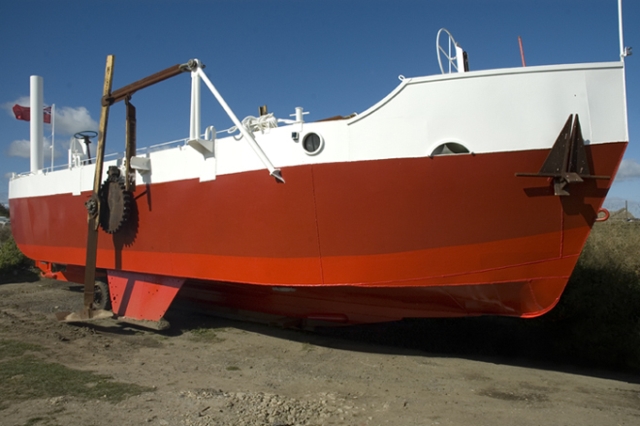
See Andrew Baldwin's website here http://www.andrewbaldwin.co.uk/.

Andrew Baldwin trained as a Master Blacksmith and Welder and worked as such for 28 years. His interest in Victorian engineering, his limitless imagination and his aptitude for working metal are what motivates him to create his outlandish mechanical marvels.
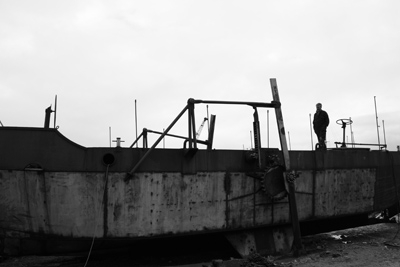
Among his creations is a truly poetic life-size sculpture (click here to see it), which, over and over again, explodes into fragments before slowly reforming into the image of its maker. He has constructed many walking machines and numerous ‘winged’ works (the largest of which spans 40 feet). ‘The Walking Boat’ is his most ambitious to date, and is the first boat he built.
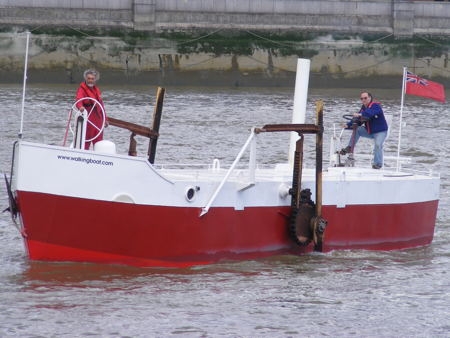
The Walking Boat, an extraordinary, kinetic work of art created by sculptor Andrew Baldwin, sailed into – or is it onto? – London on Thursday 12 May 2011 to the delight of crowds outside the Tate Modern. This astonishing 40ft walking boat took two years to construct, and is the culmination of an artist’s imaginative vision, dedication and exceptional talent as sculptor and blacksmith.

The Walking Boat was finished in 2010, and sailed from Sandwich to the Tate Modern. However, the attempt that October to walk up the beach to the Tate Modern had to be aborted.
It was supposed to be one small step for boat, one giant leap for seafaring kind.
Andrew modified the Boat over the following few months and in May 2011 successfully scaled the strand of the Tate Modern.
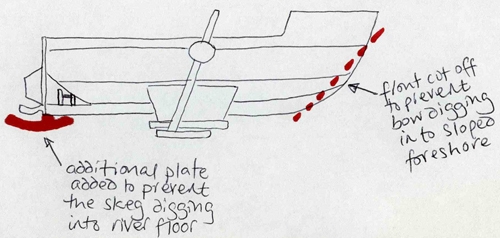
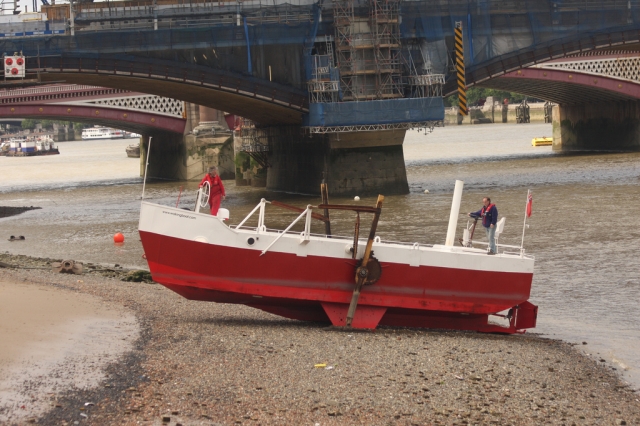
Walking Boat Steps Out
By Louisa Emery on October 19, 2010
A sculptor has given a whole new meaning to the phrase sea legs.
The farrier-turned-artist has created a boat that walks and last Thursday the vessel was intended to be strolling along the shores of the South Bank.
Artist Andrew Baldwin said: "The boat is mechanical but driven by a hydraulic motor. It walks itself, the front wheel steers the legs and the back controls the boat in the water. It is very slow but takes four foot long steps so covers a lot of ground."
The project has been a labour of love for Andrew who trained as a blacksmith after failing to get into art college and ran his own forge until his passion for sculpture took over.
He said: "Originally I was going to build a whole hull but I bought a started project, cut the top off and threw it away. It has taken two and a half years. I got the speed wrong to start with and it was more running than walking."
The sea worthy ship is currently docked at Trinity Buoy Wharf.
This is not the first time Andrew has given legs to his sculptures. The centre for creative industries located a short walk from East India DLR, is also home to his walking fish as well as a series of other moving metal artwork.
Andrew said: "I had a show at Trinity Buoy Wharf about four years ago and every time they have an open studio event I try to sneak another piece in."
Crowds gathered on the banks of the Thames below the Tate Modern but unfortunately the boat failed to walk up the beach.
Turning tides meant the boat could only step a few feet before coming to a halt at the edge of the water.
Walking Boat Trivia:
- In 1918 there was a cartoon of a passenger ship lifting itself out of the water to avoid a torpedo.
- The first walking boat (barge) was built in America by the Navy in 1947 (too late for the war effort).
- The Walking barge above used the same 'big foot' principle as the British invented Walking Dragline (Ransomes-Rapier) of 1939.
- Frank Stuart filed a patent for Britain’s first (I believe) amphibious walker, albeit in the form of a mechanical elephant, in 1950.